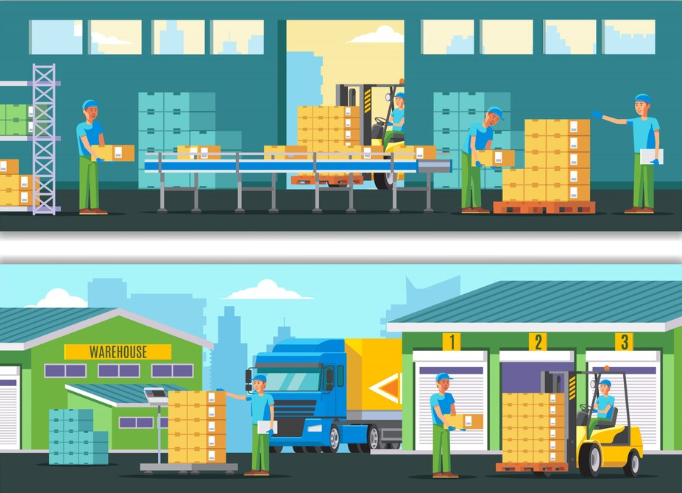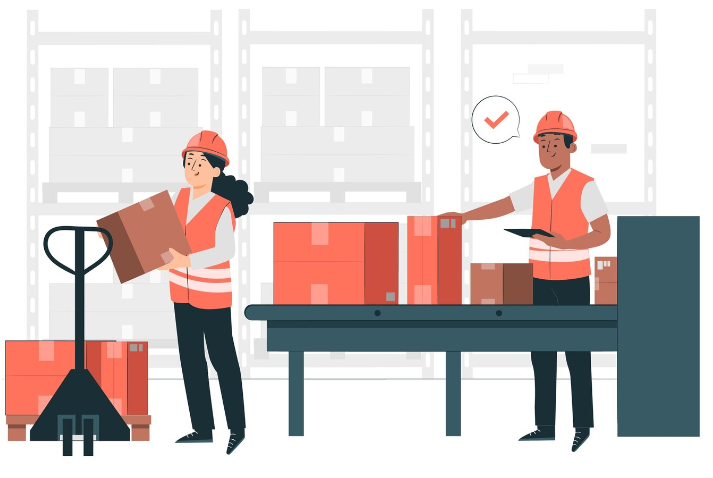Table of Contents
What Is eCommerce Warehousing? Everything You Need to Know
Time: Dec 03,2024 Author: SFC Source: www.sendfromchina.com
For ecommerce businesses, warehousing isn’t just about storing products — it’s about optimizing your entire supply chain to meet customer demands efficiently. It ensures that products are stored, managed, and shipped quickly, meeting customer expectations for fast delivery. With the rise of online shopping, understanding how ecommerce warehousing works, along with the different types available, has become essential for business growth.In this article, we’ll walk you through the various ecommerce warehousing options, their benefits, and how to choose the right one to optimize your inventory management, shipping, and overall efficiency.

1. What Is Ecommerce Warehousing
eCommerce warehousing refers to the process of storing, managing, and shipping inventory specifically tailored for online retail businesses. Unlike traditional warehousing, which often caters to bulk storage for brick-and-mortar stores, eCommerce warehousing focuses on rapid inventory turnover and efficient fulfillment of individual customer orders.In the fast-paced world of online shopping, eCommerce warehouses act as the backbone of supply chain operations, ensuring products are ready for quick delivery to customers. These facilities often incorporate advanced technology, such as warehouse management systems (WMS), automated sorting, and real-time inventory tracking, to optimize operations.
2. What Are the Types of Ecommerce Warehousing

On-demand Warehousing Solutions
On-demand warehousing is a relatively flexible and scalable solution where businesses can rent warehouse space and services as needed, without long-term commitments. It is often used by eCommerce businesses that experience fluctuations in inventory and order volumes, as it allows them to adjust their warehousing capacity dynamically based on demand.On-demand warehousing is usually facilitated through third-party logistics (3PL) providers, who offer services like inventory management, order fulfillment, and shipping. The type of warehousing helps businesses reduce overhead costs associated with owning or leasing large facilities and can be particularly beneficial for smaller or growing eCommerce businesses that need agility.
Fulfillment Centers or Distribution Centers
Compared to traditional warehouses, fulfillment centers or distribution centers focus more on storing inventory, picking, packing, and shipping products directly to customers. They are integral to the order fulfillment process, especially in eCommerce, where fast, accurate shipping is critical to customer satisfaction.Dropshipping
Dropshipping is not technically a type of eCommerce warehousing, though it is a popular business model in eCommerce. In a dropshipping model, the eCommerce store does not keep inventory on hand. Instead, when a customer places an order, the store purchases the product directly from a third-party supplier (often a manufacturer or wholesaler) who ships the product directly to the customer. As a result, the retailer never handles or stores the inventory themselves.Dedicated Warehousing
In Dedicated Warehousing, a business rents or owns an entire warehouse space for its exclusive use. The warehouse is set up and managed specifically for the company’s needs, and the operations inside the warehouse (inventory management, order fulfillment, etc.) are tailored to the company’s specific requirements.Shared Warehousing
Shared warehousing involves multiple businesses sharing the same warehouse facility, typically managed by a third-party logistics (3PL) provider. Itl is particularly beneficial for eCommerce companies that may not require a full warehouse or are looking for a more cost-effective solution to handle their inventory and fulfillment operations. By sharing the space and resources, businesses can save significantly on operational costs while still accessing professional warehousing services.3. Benefits of Ecommerce Warehousing

Faster Delivery Times
A well-organized warehouse enables quicker order processing, which translates to faster shipping times. Customers love speedy delivery, and it’s often a deciding factor when choosing where to shop online.Reduced Operational Errors
With clear storage systems and inventory tracking, the chances of picking and packing the wrong items are significantly reduced. It minimizes costly returns and improves customer satisfaction.Scalability
As your business grows, a warehouse provides the flexibility to store larger inventories without worrying about running out of space. Scalability is vital during peak seasons, like holidays.Inventory Visibility
Modern warehousing solutions often integrate with inventory management software, offering real-time insights into stock levels. It helps prevent stockouts, manage restocking schedules, and forecast demand accurately.Cost Savings on Shipping
By strategically locating your warehouse closer to your target audience, you can reduce shipping costs and transit times. It is especially useful for businesses with nationwide or international customers.Improved Returns Management
Warehousing systems simplify the process of managing returns. They allow you to inspect, restock, or dispose of returned items efficiently, which is crucial in building trust with your customers.Focus on Core Business Operations
By outsourcing warehousing to third-party providers or using fulfillment centers, you can focus on marketing, customer service, and other key aspects of your business.4. How to Choose an Ecommerce Warehousing

Location
Strategically located warehouses reduce shipping times and costs. Facilities near major customer bases or transportation hubs can significantly enhance delivery efficiency.Technology Integration
A good warehousing solution integrates seamlessly with eCommerce platforms, allowing real-time inventory tracking, automated updates, and streamlined operations.Scalability
Your warehousing needs will evolve as your business grows. Choosing a solution that can scale with your operations ensures smooth transitions during peak periods or expansion phases.Cost Considerations
Evaluate costs beyond just rental fees. Consider expenses for labor, utilities, technology, and shipping. Balance affordability with the quality of services provided to ensure optimal value.5. Challenges of Ecommerce Warehousing

High Operational Costs
Rent, labor, and technology investments can add up quickly. Small businesses may struggle to afford these expenses without scaling efficiently.Demand Fluctuations
Seasonal demand spikes and unpredictable trends can strain warehouse capacity and lead to inefficiencies.Managing Returns Effectively
Ecommerce businesses face high return rates, necessitating efficient reverse logistics. Processing returns can be labor-intensive and costly.Integrating with Technology
Seamless integration between ecommerce platforms and warehouse systems is crucial. Technical hiccups can disrupt operations and lead to customer dissatisfaction.6. Get Started with SFC Ecommerce Warehousing
As the first China fulfillment service provider, SFC has more than 15 years of order fulfillment experience in China and serves 10,000+ e-commerce sellers and crowdfunding sponsors.
Automatic fulfillment process
a. Auto-sync incoming orders from all eCommerce Stores.b. Preset auto shipping rules to optimize the budget.
c. With fully automated equipment, more than 500,000 orders will be shipped out in 24H.
Standout service
a. ≥99.9% inventory accuracyb. <3 out of 1,000 order discrepancy
c. 99.98% delivery within 24 hours
d. 24/7 online customer team
Customizable eCommerce Shipping Solutions
SFC eCommerce door-to-door shipping covers 220 regions and countries around the world, including emerging markets and remote areas.Real-Time Tracking
Tracking information will be updated in 24 Hours to your eCommerce marketplace and a tracking email under your brand name will be sent to your buyer too. For your convenience, you can track your order status on your SFC dashboard.7. Conclusion
Ecommerce warehousing is the backbone of online retail, enabling businesses to store, manage, and distribute products efficiently. From selecting the right type of warehouse to addressing challenges, optimizing your warehousing strategy can significantly impact your business’s success. By investing in a solution tailored to your needs, you can streamline operations, enhance customer satisfaction, and scale effectively in a competitive market.8. FAQs
Q: Can small businesses afford eCommerce warehousing?A: Absolutely! Shared warehouses or 3PL providers offer cost-effective solutions tailored to small businesses.
Q: What’s the difference between a fulfillment center and a warehouse?
A: A warehouse primarily stores inventory, while a fulfillment center handles storage, packing, and shipping orders.
Q: How do I know if I need a warehouse?
A: If your inventory outgrows your home or office space, or you’re struggling with timely order fulfillment, it’s time to consider warehousing.
Q: Is dropshipping a form of eCommerce warehousing?
A: Not exactly. In dropshipping, the supplier stores and ships products directly to customers, so you don’t need a physical warehouse.
 Post Views:397
Post Views:397
Copyright statement: The copyright of this article belongs to the original author. Please indicate the source for reprinting.
Previous Post
Stock Keeping Unit (SKU): What Is SKU and Why It Matters
Next Post
TAGS
Hot Research
Get a Custom China Fulfillment Solution with FREE Storage for 30 Days
 Want to know about our services, fees or receive a custom quote?
Want to know about our services, fees or receive a custom quote?
 Please fill out the form on the right and we will get back to you within a business day.
Please fill out the form on the right and we will get back to you within a business day.
 The more information you provide, the better our initial response
will be.
The more information you provide, the better our initial response
will be.





 TAGS:
TAGS: